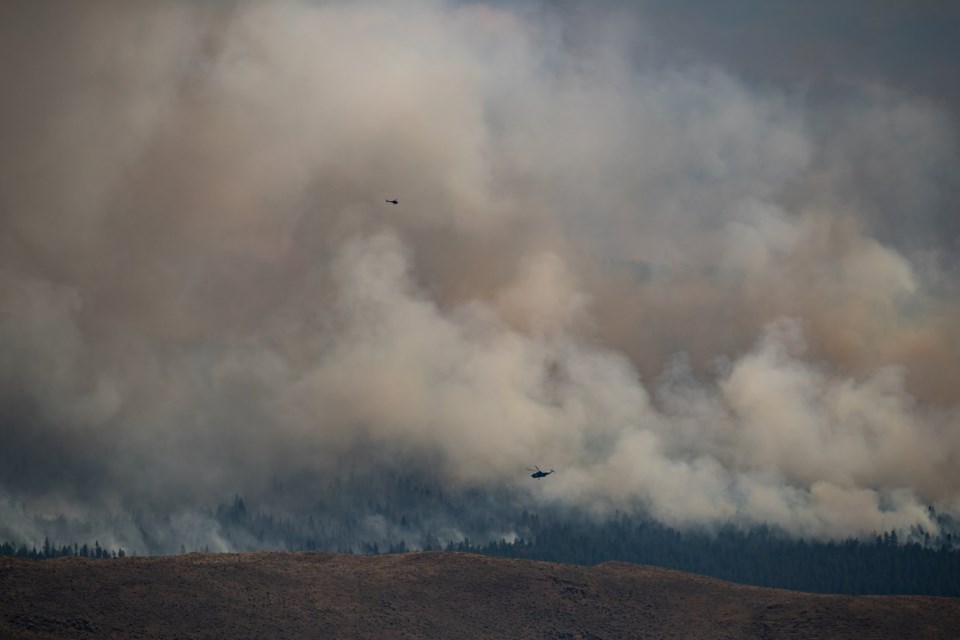VANCOUVER — British Columbia's emergency management minister says the province is proactively working to secure extra firefighters to deal with what she called the "potential for a drastically accelerated wildfire situation."
Bowinn Ma told a briefing on Thursday that B.C. was seeking out-of-province help from six unit crews representing about 180 specialized wildfire fighters.
Ma said about 500 of the province's full complement of 2,000 firefighters were currently deployed, but the province was seeking outside help early as the situation worsened due to a heat wave and ongoing dry conditions.
"We do want to be prepared, and so by being proactive in our request for additional resources, we can ensure that the lag that it often takes for additional resources to come in from out of province doesn't impact our ability to protect communities and protect British Columbians," said Ma.
Neither Ma nor Cliff Chapman, the director of provincial operations with the BC Wildfire Service, said where the province was hoping to get the firefighters.
However, Ma said the province was also seeking additional incident management teams, advanced planners, and fire behaviour specialists from Australia and elsewhere.
Last year, crews from around the world including South Africa, Australia, South Korea and the United States helped B.C. battle its most destructive fire season.
Chapman said they are also looking for additional firefighting planes that scoop water from lakes and dump them on fires, to supplement the fleet of 135 aircraft currently flying in the province.
He said crews had been “extremely” busy in the northeast of the province since the end of April working to keep communities in the Fort Nelson and Fort St. John areas of northeastern B.C. safe.
Chapman said the outside firefighters would ensure wildfire crews soon “have the adequate breaks that they need,” allowing them to continue working into July, August and September.
“It's also to ensure that we are prepared and so that we do not have to take all of our resources out of the north if we start to see fires in the central and the south of British Columbia," said Chapman.
“We need to ensure we have adequate resourcing for today, but also for the next two months and so, we're asking early so that we can get those resources into B.C."
Wildfire activity has been erupting in recent days, with about 150 active wildfires in B.C., up from fewer than 100 at the start of the week.
Ma said most were in the Cariboo and northeast regions, and while some of the the province had benefited from cooler and wetter weather in May and June, the fire season was "well underway” in the north.
Chapman said more than 30 fires had started within 24 hours in the Cariboo Fire Centre, and firefighting crews were "flooding" the area with resources, including air tankers and helicopters.
Chapman said a cold front that swept through the northern part of the province on Tuesday resulted in 13,000 lightning strikes.
British Columbia's wildfire service says forest fuels are more susceptible to fire starts after seven consecutive days of extreme heat, with new blazes prompting two new evacuation orders in recent days.
The latest spans a portion of the District of Wells, about 80 kilometres east of Quesnel in the province's central Interior, where the BC Wildfire Service map shows a cluster of more than two dozen new fires in the area.
The district issued the order at 10 p.m. Wednesday night, saying the 70-hectare Cornish Mountain wildfire is a threat to life and safety, and residents must leave right away.
The order covers the Eight- and Nine-Mile Lake Areas, Cornish Lake, and Mine Sites areas, while an evacuation alert is in effect for the rest of the district.
The Fort Nelson First Nation issued an evacuation order Tuesday for its Kahntah reserve, telling residents they had to leave by boat due to the threat of an out-of-control blaze discovered the day before.
Two wildfires are considered fires of note, meaning they are either highly visible or pose a threat to safety or infrastructure.
The BC Wildfire Service says smoke from the two-square-kilometre Little Oliver Creek fire will be visible from Highway 16 and the Terrace, B.C. area.
Meanwhile, the 3.5-square-kilometre Hook Creek fire is burning out of control to the north, near a stretch of the Alaska Highway along the boundary with Yukon.
While temperatures have cooled to more seasonal levels along B.C.'s coast, Environment Canada is maintaining heat warnings for much of the southern Interior and southeast corner of the province.
A severe thunderstorm watch is in effect for the Fort Nelson area which has been the epicentre for drought and fire activity so far this year.
The wildfire service has also announced a provincewide campfire ban is set to take effect Friday at noon, with the exception of the Haida Gwaii, which Ma said had a distinct climate.
Ma also used the briefing to pay tribute to B.C. firefighter Devyn Gale, who was killed by a falling tree in B.C.'s southern Interior last year. Saturday marks the first anniversary of her death.
Ma said that Gale, who was 19, was "a bright light taken far too soon" while she helped protect the province.
This report by The Canadian Press was first published July 11, 2024.
Nono Shen, The Canadian Press




